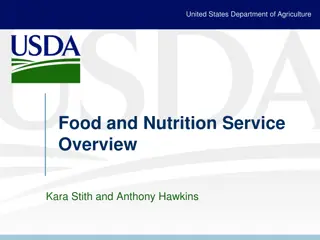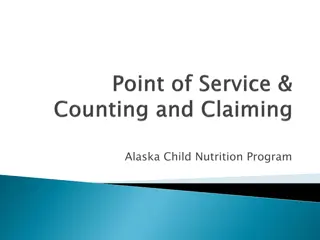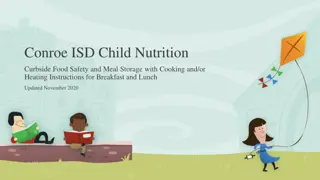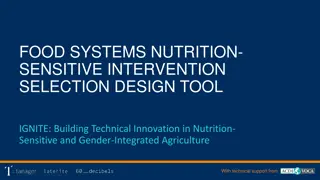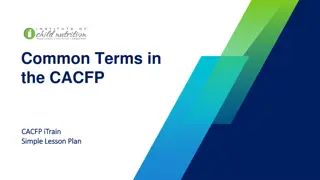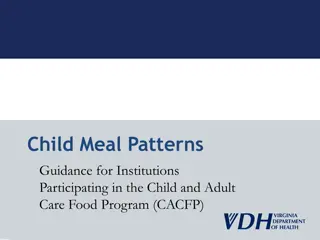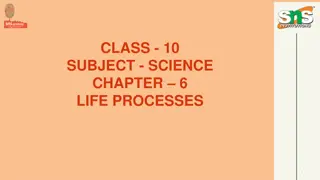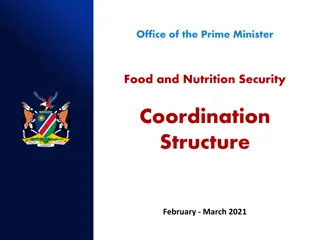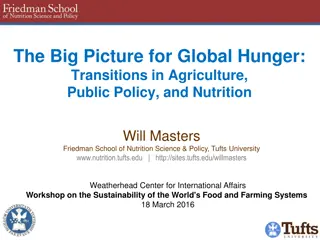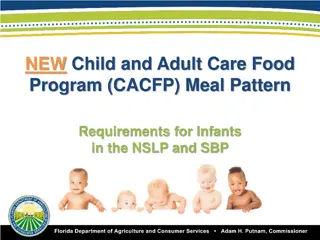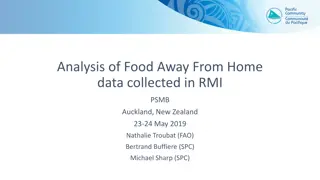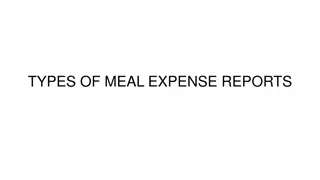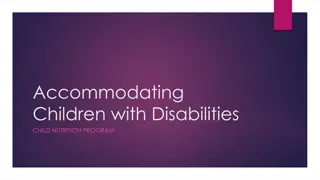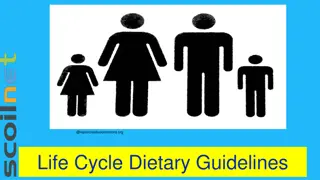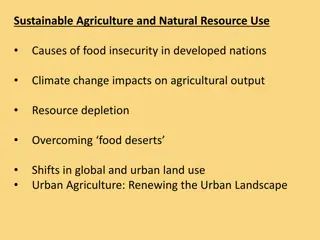Overview of U.S. Department of Agriculture Food and Nutrition Service Meal Patterns
The U.S. Department of Agriculture Food and Nutrition Service implements meal pattern changes for school meals, including requirements for fruits, vegetables, grains, milk, and calorie limits. Changes in specific school years, such as offering only fat-free and low-fat milk, increasing whole grains, and restricting sodium content, are outlined. The meal patterns aim to provide healthier food options for students through a Food-Based Menu Planning approach and establish age/grade groups for meal planning flexibility.
Download Presentation

Please find below an Image/Link to download the presentation.
The content on the website is provided AS IS for your information and personal use only. It may not be sold, licensed, or shared on other websites without obtaining consent from the author. Download presentation by click this link. If you encounter any issues during the download, it is possible that the publisher has removed the file from their server.
E N D
Presentation Transcript
U.S. Department of Agriculture Food and Nutrition Service
Overview Meal pattern overview & timeline Age/grade groups Meal pattern components in SY 2013/14 Fruits/Vegetables Grains (meat/meat alternate) Milk Calories OVS Miscellaneous
SBP Changes Effective SY 2012-2013 Offer only fat-free (flavored or unflavored) and lowfat (unflavored) milk Saturated fat limit <10% calories
SBP Changes Effective SY 2013-2014 Half of weekly grains must be whole grain-rich Minimum weekly grain requirement* *Maximum not assessed for SY 2013-14, per memo SP 26-2013 Calorie ranges Zero grams of trans fat per portion A single Food-Based Menu Planning approach Establish age/grade groups: K-5, 6-8 and 9-12 3-year administrative review cycle includes SBP States conduct weighted nutrient analysis on one week of menus
SBP Changes Effective SY 2014-2015 Fruit quantity to increase to 5 cups/week (minimum 1 cup/day) All grains must be whole grain-rich Target 1 for average weekly sodium limit Under OVS, meals selected by students must contain a fruit (or vegetable if using substitution)
Additional Future SBP Changes SY 2017-2018 Target 2 sodium restriction SY 2022-2023 Final Target sodium restriction
Age/Grade Groups Three age/grade groups for planning breakfasts K-5 6-8 9-12 Flexibility in menu planning at breakfast All three grade group requirements overlap at breakfast A single menu can be used for all groups
Fruits Component Must offer at least cup of fruit and/or vegetables daily No maximum limit on fruit/vegetable quantities Fresh, frozen, canned, and dried forms allowed No fruit juice limit in SY 2013-14 No starchy vegetable substitution limits No OVS requirement to take fruit or vegetable Student may decline any one item
Fruits Component Temporary allowance for frozen fruit with added sugar SY 12/13 and SY 13/14 Schools may offer a: Single fruit type Single vegetable Combination of fruits Combination of vegetables Combination of fruits and vegetables
Fruits- Smoothies Fruit smoothies prepared in-house may credit toward both the fruit and milk components Commercial products may only credit toward fruit component All meal components must be offered in the required minimum amounts Must still offer variety of fluid milk choices Additional fruit offerings encouraged Refer to memo SP 36-2012, released 7/11/12
Grains Component Flexibility in menu planning and complying with weekly ranges for grains in SY 2013-14 SFAs compliant if meeting weekly minimum; maximum will not be assessed Flexibility allows: More time for the development of food products that fit the NSLP meal pattern More menu options for meal planners and students More time for students to adjust to meal pattern changes
Grains Component: Flexibility No impact on: Daily and weekly minimum for grains for breakfast Weekly calorie ranges are in effect Trans fat and saturated fat also apply
Whole Grain-Rich Foods In SY 2013-14, half of the grains offered must be whole grain-rich (WGR) All grains must be WGR by SY 2014-15 Increasing availability commercially USDA Foods offers WGR flour, oats, pancakes, tortillas, and rice Traditional grits ok in SY 2013-14 as long as other grains offered are whole grain-rich
Grain-based Desserts No grain-based dessert limit at breakfast Sugar in grain items is allowed No grain-based dessert restriction at breakfast (lunch only) Some grain products can only be served as desserts in lunch/not allowable in breakfast (brownies, cookies)
Fortification A ready-to-eat breakfast cereal must be fortified to meet program requirements 100% whole grain cereals do not need to be fortified Check cereal products for an ingredient statement on the side or back of the box Ingredients: Wheat bran, sugar, psyllium seed husk, oat fiber, contains 2% or less of salt, baking soda, caramel color, annatto color, BHT for freshness. Vitamins and Minerals: Vitamin C (sodium ascorbate, ascorbic acid), niacinamide, vitamin B6 (pyridoxine hydrochloride) .etc .
Optional Meat/Meat Alternates New SBP meal pattern does not require a meat/meat alternate SFAs that wish to offer a meat/meat alternate at breakfast have two options Offer meat/meat alternate in place of grains Offer a meat/meat alternate as an extra item
Meat/Meat Alternate In Place of Grains When offering a meat/meat alternate in place of grains in SBP Must also offer at least 1 ounce equivalent of grains daily Must count the meat/meat alternate toward the weekly grains range and the weekly dietary specifications
Meat/Meat Alternates as Extras When offering a meat/meat alternate as an extra item Must also offer at least 1 ounce equivalent of grains daily The meat/meat alternate does not count toward the grains range The meat/meat alternate does not count for OVS purposes Meat/meat alternate must fit within the weekly dietary specifications
OVS: Components vs. Items Always offer all three components in at least the required amounts For OVS, must offer at least four food items at breakfast Students may decline one food item Regulatory definition: A food item is a specific food offered within the food components For purposes of OVS, an item is the daily required minimum amount of each food component that a child can take 1 cup of milk 1 oz eq of grains cup of fruit (or veg)* *NOT required in SY 2013-14
OVS- Grains (part 1) A large grain counts as more than one food item for purposes of OVS in breakfast e.g. 2 oz muffin = 2 food items Unchanged from prior OVS practice In addition to the 2 oz grain, at least 2 other food items must also be offered to have OVS Student cannot decline the 2oz grain item Examples: School offers 2 oz eq muffin, cup apples, and milk (decline milk or apples) School offers 2 oz eq muffin, cup apples, cup juice, and milk (decline milk or a fruit choice)
OVS- Grains (part 2) Grains-meat/meat alternate combination items When counting the meat/meat alternate as grains, the combo may count as two food items Example: egg sandwich w/ 1 oz eq of grains and 1 oz eq of m/ma counting as grains = 2 food items If not counting the meat/meat alternate toward the grains component, the combo is one food item Three additional items must be offered to have OVS Student may decline the combination Example: egg sandwich w/ 1 oz eq of grains and 1 oz eq of m/ma not counting as grains (extra) = 1 food item
OVS- Grains (part 3) Allowing students to take two of the same grain item If a menu planner offers two different 1 oz eq grain items at breakfast, a student may be allowed to take two of the same grain and count as two items At the discretion of the menu planner to allow duplicates Example: school offers milk and fruit, plus two grains: cereal (1 oz eq) and toast (1 oz eq) Student could select fruit and two toasts 2nd toast selected in place of other grain offered (cereal) Only one item (milk) declined
Pre-plating/Bundling Remember OVS is not required at breakfast Pre-plating/bundling is allowed Encouraged to offer choices to the extent possible
Technical Assistance Resources FNS New Meal Pattern website (http://www.fns.usda.gov/cnd/Governance/Legislatio n/nutritionstandards.htm) Timeline Powerpoint presentations for training Recently released Q&As, other policy memos Best Practices Sharing Center SFAs and States can share resources and tools they use to serve healthy menus that meet the new school meal regulations by uploading information to this site http://healthymeals.nal.usda.gov/bestpractices)





